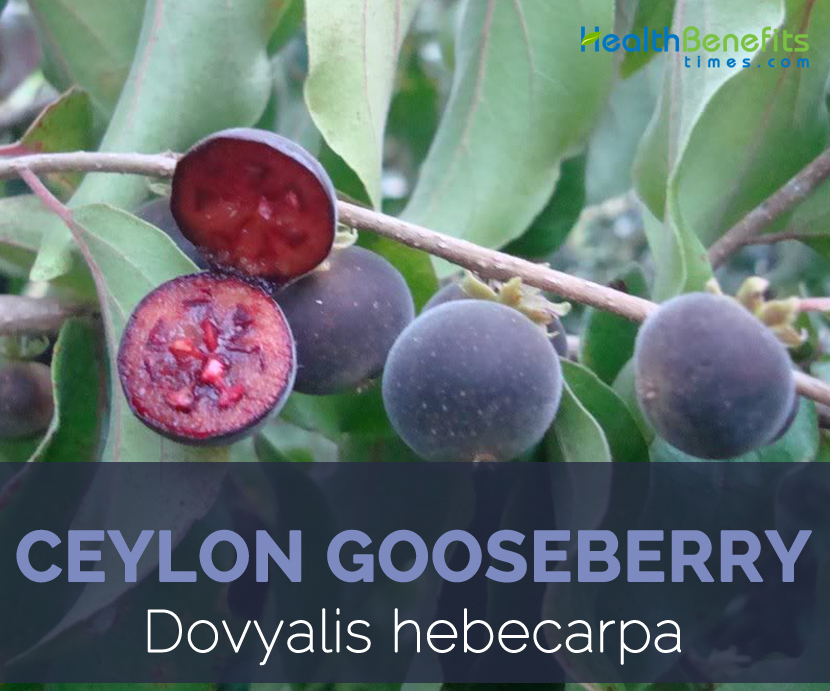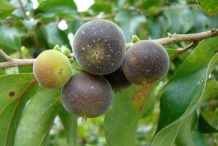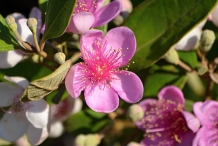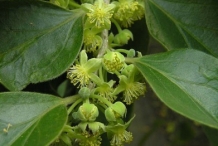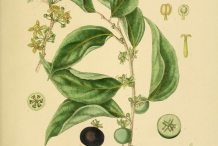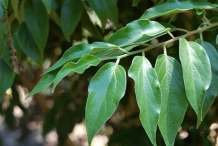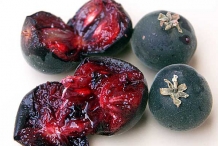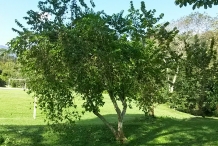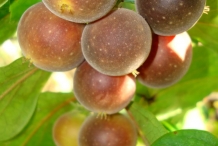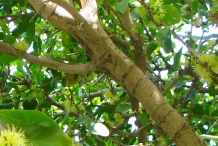| Ceylon gooseberry Quick Facts |
| Name: |
Ceylon gooseberry |
| Scientific Name: |
Dovyalis hebecarpa |
| Origin |
Native to Sri Lanka and southern India |
| Colors |
Green turning to orangey brown to maroon-purple |
| Shapes |
Globose, berry up to 2.5 cm diameter, velvety pubescent |
| Flesh colors |
Purple-red |
| Taste |
Slightly sweeter, sour and astringent. |
| Calories |
63 Kcal./cup |
| Major nutrients |
Vitamin C (108.89%)
Total dietary Fiber (38.42%)
Vitamin B2 (30.77%)
Iron (15.00%)
Phosphorus (3.71%)
|
| More facts about Ceylon gooseberry |
Dovyalis hebecarpa, with common names Ceylon gooseberry, ketembilla, and kitambilla, is a plant in the genus Dovyalis, native to Sri Lanka and southern India. The fruit are often eaten fresh, or made into jam. Some cultivars have been selected for being thorn less (making harvesting easier) and for larger fruit. Apart from Ceylon gooseberry it is also known as Ketembilla, Kitembilla, kei apple, Puerto Rican cranberries, and tropical apricots. The tree takes about 2-3 years to fruit. Fruit is quite juicy, extremely acidic and is mostly used for making preserves, jelly, jam and juice.
Plant
Ceylon gooseberry is a shrub or small, dioecious perennial tree growing to 4–6 m high with long, slender, arching, wide-spreading branches. The trunk and lower branches have sharp, 4 cm long spines. Leaves are alternate, simple, and elliptic to ovate, 7–10 cm long, 2–3.5 cm wide, wavy-margined, gray-green, finely velvety, with pinkish, woolly petioles, and thin in texture. The flowers are inconspicuous, solitary or clustered, with no petals. It is dioecious, with male and female flowers on separate plants, though some female plants are parthenogenetic. Flowers are greenish-yellow, apetalous, 1.25 cm across and axillary.
Fruit
Ceylon gooseberry is globose, berry up to 2.5 cm diameter, velvety pubescent. Fruit is green when young turning to orangey brown to maroon-purple when mature. Fruit has thin bitter skin coated with short, grayish-green, velvety hairs, unpleasant in the mouth that encloses purple-red colored flesh. The fruit normally has acidic flavor and slightly sweeter also sour and astringent in taste. The pulp is very juicy, extremely acid, purple-red, enclosing 9–12 pubescent seeds about 6 mm long. Every fruit contains roughly 5-9 small hairy seeds. Since Ceylon gooseberry has acidic flavor it is mostly used in making preserves, jelly, jam and juice. Kitembilla fruit, which taste similar to a gooseberry (they are sometimes called “Ceylon Gooseberry”), are often eaten fresh, or made into jam. Some cultivars have been chosen for being thorn less (making harvesting easier) and larger fruit.
History
Ceylon gooseberry is native to Sri Lanka, previously known as Ceylon. Doctor David Fairchild brought it to the United States around the turn of the 20th century, despite the fact that he didn’t care for the fruit’s flavor. From there it journeyed to Hawaii where it was proposed for use as a shrub in hedgerows, and wound up becoming an important part of the island chain’s economy and cuisine. The Ceylon gooseberry is also grown in Puerto Rico, where it has become naturalized in the country’s landscape, as well as various parts of South America, South Africa, and India. It is also found in Israeli orchards. Today, the fruit grows in Israel, Florida and Hawaii of the US, and limited parts of Central America, and South Africa. It is also naturalized in Puerto Rico.
Nutritional Value
Apart from their slightly sweeter, sour and astringent taste, Ceylon gooseberry is a good source of nutrients, vitamins and minerals. Consuming 100 gram of Ceylon gooseberry offers 98 mg of Vitamin C, 14.6 g of Total dietary Fiber, 0.4 mg of Vitamin B2, 1.2 mg of Iron, 26 mg of Phosphorus, 1.2 g of Protein, 0.8 g of Total Fat, 0.3 mg of Vitamin B3, 0.02 mg of Vitamin B1, 13 mg of Calcium.
Health benefits of Ceylon Gooseberry
Ceylon Gooseberry is a fruit native to South Asia and is highly regarded for its numerous health benefits due to its rich nutritional content and medicinal properties. Here are some of the potential health benefits of Ceylon Gooseberry:
1. Rich in Nutrients
Ceylon Gooseberries are packed with vitamins and minerals that your body needs. They have a lot of vitamin C, which helps the nervous system, helps wounds heal, and makes collagen. Also, they have vitamin A, which is important for good eyesight, healthy skin, and a strong immune system.
2. Antioxidant Powerhouse
Antioxidants like vitamin C, flavonoids, and tannins are all in these gooseberries. Antioxidants help get rid of dangerous free radicals in the body. This lowers the risk of oxidative stress and chronic diseases like cancer and heart disease.
3. Immune System Support
Ceylon Gooseberries have a lot of vitamin C, which helps the defence system fight off infections and illnesses. It makes the body make more white blood cells, which are very important for the immune system.
4. Heart Health
The potassium in Ceylon Gooseberries works against the effects of sodium in the body to keep blood pressure in check. This can help keep your heart healthy and lower your chance of getting high blood pressure.
5. Digestive Health
Ceylon Gooseberries are a good source of fibre, which helps your body digest food well. Fibre helps keep the bowels moving regularly, prevents constipation, and adds to a healthy gut microbiome.
6. Skin Nourishment
Antioxidants, especially vitamin C, help make collagen, which makes skin more elastic and makes lines less noticeable. The vitamins and minerals help keep the face healthy and bright.
7. Eye Health
Vitamin A, which is found in Ceylon Gooseberries, is important for keeping your eyes healthy. It helps keep your eyes healthy, prevents night blindness, and may lower your chance of age-related macular degeneration.
8. Anti-Inflammatory Properties
Some chemicals in Ceylon Gooseberries can help reduce inflammation. Chronic inflammation, which is linked to many diseases, such as heart disease, diabetes, and arthritis, may be lessened by regular drinking.
9. Blood Sugar Regulation
The fibre in these gooseberries can help control blood sugar by making it take longer for glucose to be absorbed. Because of this, they are a good choice for people with diabetes or who want to control their blood sugar levels.
10. Bone Health
Calcium and phosphorus, which are found in Ceylon Gooseberries, are important minerals for keeping bones and teeth strong. If you get enough of these minerals, your bones will be stronger and you won’t get osteoporosis.
11. Weight Management
The fibre in Ceylon Gooseberries helps you feel full and keeps you feeling full for longer. This can help you lose weight by stopping you from eating too much and keeping track of the calories you take in.
12. Hydration Support
Because they have a lot of water, Ceylon Gooseberries can help you stay hydrated, especially when it’s hot or when you’re doing a lot of physical activity.
How to eat
- The very sour and astringent fruits are almost too acid to eat raw and this is compounded by its velvety hairs which are offensive in the mouth.
- Fruits are excellent for making preserves, jelly, jam and juice.
- In Hawaii, there are recipes for juice, spiced jelly, ketembilla-papaya jam, ketembilla-guava jelly, and ketembilla-apple butter.
- Ketembilla is respected mainly as a source of jelly for export in Israel.
- Since the pulp of the fruit is very juicy, it is either used as a flavoring for beverages or for preserves.
Other Traditional benefits of Ceylon gooseberry
- The fruit has a high content of vitamin C which is essential for healing wounds and for repairing and maintaining bones and teeth.
https://www.youtube.com/watch?v=_yIMnijns5k
Other Facts
- Dovyalis hebecarpa is also planted as an ornamental or as wind-break.
References:
http://theindianvegan.blogspot.com/2012/10/all-about-ceylon-gooseberry.html
https://en.wikipedia.org/wiki/Dovyalis_hebecarpa
http://www.fruitsinfo.com/ceylon-gooseberry-tropical-fruits.php
https://www.hort.purdue.edu/newcrop/morton/ketembilla_ars.html
http://growfruit.tripod.com/ceylon.htm
http://davesgarden.com/guides/pf/go/103098/
http://www.growplants.org/growing/dovyalis-hebecarpa
https://www.rhs.org.uk/Plants/158475/Dovyalis-hebecarpa/Details
http://tropical.theferns.info/viewtropical.php?id=Dovyalis+hebecarpa
http://www.thjardins.com.br/php/shopping_produtos_detalhe.php?produto=215
http://www.hear.org/pier/species/dovyalis_hebecarpa.htm
https://npgsweb.ars-grin.gov/gringlobal/taxonomydetail.aspx?id=14617
http://davesgarden.com/guides/pf/go/103098/
Comments
comments


